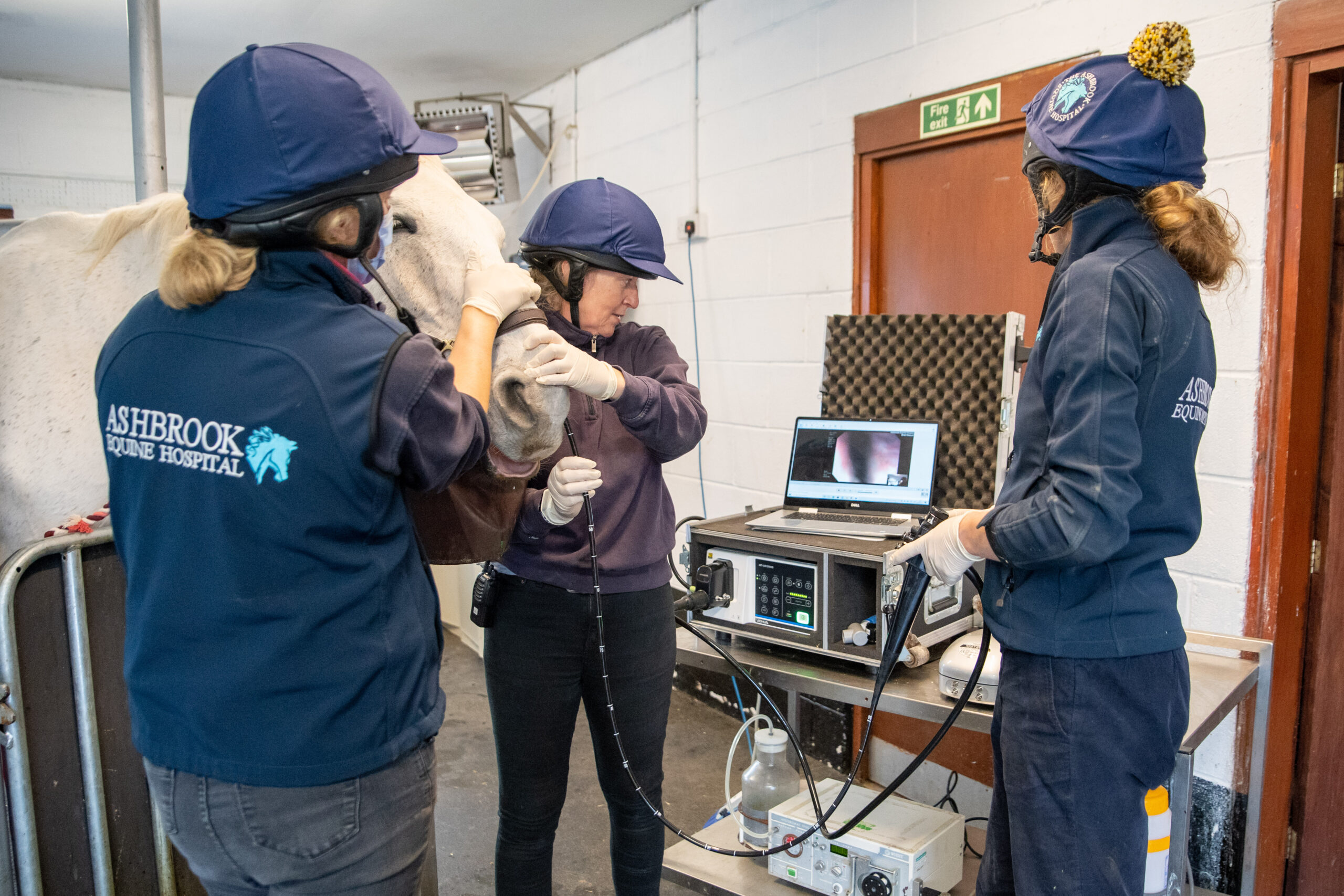Internal medicine
We have an extensive range of facilities at our hospital, enabling us to provide a highly specialised service for the investigation and treatment of medical problems.
Common medical conditions that we investigate and treat include gastrointestinal problems such as colics, diarrhoea or weight loss, respiratory problems, liver and kidney disease, neurological problems (including head-shaking syndrome), cardiology cases, ophthalmology problems and sick foals.
These diagnostic techniques, together with our in-house laboratory and CCTV-monitored intensive care stables, enable us to provide the best possible care for critically ill patients, and for horses requiring investigation of disease.
Ophthalmology
Ophthalmology
Horses can be affected by a range of ocular conditions, ranging from cases of uncomplicated conjunctivitis to severe painful uveitis, foreign bodies and deep corneal ulceration.
Eye diseases may present with a very sudden onset; these cases should be viewed as true emergencies so please call us to arrange a visit as soon as possible. .
In order to perform a thorough ocular examination, it may be necessary to sedate the horse.
An ophthalmoscope will be used to visualise the cornea, lens, iris, retina and inner chambers of the eye.
We will often put an orange dye (fluorescein) into the horse’s eye to help detect any ulcers or scratches on the surface of the cornea.
In some conditions, like uveitis, the front part of the eye may become very cloudy and it may not be possible to see to the back of the eye with an ophthalmoscope.
In these cases, our high quality, hospital-based ultrasound may be used to assess these hidden structures.
Treatment
Depending on the condition, many eye problems can be treated by topical eye ointments applied several times daily.
Very aggressive infections or ulcers may need a cocktail of different medications applied every one or two hours.
In these cases we may advise that the horse is admitted to the hospital and an ocular lavage system placed.
This allows easy and frequent application of eye drops with minimal distress to the horse.
Ophthalmology
Horses can be affected by a range of ocular conditions, ranging from cases of uncomplicated conjunctivitis to severe painful uveitis, foreign bodies and deep corneal ulceration.
Eye diseases may present with a very sudden onset; these cases should be viewed as true emergencies so please call us to arrange a visit as soon as possible. .
In order to perform a thorough ocular examination, it may be necessary to sedate the horse.
An ophthalmoscope will be used to visualise the cornea, lens, iris, retina and inner chambers of the eye.
We will often put an orange dye (fluorescein) into the horse’s eye to help detect any ulcers or scratches on the surface of the cornea.
In some conditions, like uveitis, the front part of the eye may become very cloudy and it may not be possible to see to the back of the eye with an ophthalmoscope.
In these cases, our high quality, hospital-based ultrasound may be used to assess these hidden structures.
Treatment
Depending on the condition, many eye problems can be treated by topical eye ointments applied several times daily.
Very aggressive infections or ulcers may need a cocktail of different medications applied every one or two hours.
In these cases we may advise that the horse is admitted to the hospital and an ocular lavage system placed.
This allows easy and frequent application of eye drops with minimal distress to the horse.
Gastroscopy and endoscopy
Gastroscopy allows us to visualise the internal lining of the equine stomach and is the only way to diagnose gastric ulceration.
Signs of gastric ulceration include altered rideability, poor performance, girthiness, recurrent colic or poor body condition.
The gastroscope also enables us to biopsy the first part of the small intestine in cases of weight loss or suspected small intestinal disease.
Video endoscopy
Our video endoscopy equipment allows for the detailed examination of the upper and lower respiratory tracts.
In the upper respiratory tract, we will use the endoscope for identification of nasal, laryngeal and guttural pouch related problems.
In addition to the visualisation of the lower respiratory tract, the endoscope can be used to collect samples from the lungs or the trachea.
These methods of sampling are especially beneficial in cases of equine asthma syndrome (EAS), recurrent airway obstruction (RAO), bronchopneumonia or other disease processes in the lungs.
Overground endoscopy
We are also able to offer overground endoscopy by arrangement, to assess respiratory noises made when the horse is exercising.
This provides a dynamic assessment of the upper respiratory tract, enabling the most appropriate treatment to be prescribed or targeted surgical procedures planned.
Gastroscopy allows us to visualise the internal lining of the equine stomach and is the only way to diagnose gastric ulceration.
Signs of gastric ulceration include altered rideability, poor performance, girthiness, recurrent colic or poor body condition.
The gastroscope also enables us to biopsy the first part of the small intestine in cases of weight loss or suspected small intestinal disease.
Video endoscopy
Our video endoscopy equipment allows for the detailed examination of the upper and lower respiratory tracts.
In the upper respiratory tract, we will use the endoscope for identification of nasal, laryngeal and guttural pouch related problems.
In addition to the visualisation of the lower respiratory tract, the endoscope can be used to collect samples from the lungs or the trachea.
These methods of sampling are especially beneficial in cases of equine asthma syndrome (EAS), recurrent airway obstruction (RAO), bronchopneumonia or other disease processes in the lungs.
Overground endoscopy
We are also able to offer overground endoscopy by arrangement, to assess respiratory noises made when the horse is exercising.
This provides a dynamic assessment of the upper respiratory tract, enabling the most appropriate treatment to be prescribed or targeted surgical procedures planned.




